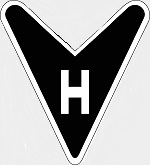Luft-X LUFT004 German Horten Ho 229 Fighter Bomber [Bonus Pair of Jumo 004 Turbojet Engines] (1:72 Scale)
"Hitler's instincts, as always, veered towards attack as the best form of defense. He looked, as did - impatiently and more and more disbelievingly - large numbers of ordinary Germans, to the chance to launch devastating weapons of destruction against Great Britain, giving the British a taste of their own medicine and forcing the Allies to rethink their strategy in the air-war. Here, too, his illusions about the speed with which the "wonder-weapons" could be made ready for deployment, and their likely impact on British war strategy, were shored up by the optimistic prognoses of his advisers."
- Ian Kershaw, "Hitler: 1936-1945 Nemesis"
 The Horten H.IX, RLM designation Ho 229 (often called Gotha Go 229 because of the identity of the chosen manufacturer of the aircraft) was a German prototype fighter/bomber designed by Reimar and Walter Horten and built by Gothaer Waggonfabrik late in World War II. It was the first pure flying wing powered by jet engines.
The Horten H.IX, RLM designation Ho 229 (often called Gotha Go 229 because of the identity of the chosen manufacturer of the aircraft) was a German prototype fighter/bomber designed by Reimar and Walter Horten and built by Gothaer Waggonfabrik late in World War II. It was the first pure flying wing powered by jet engines.
The design was a response to Hermann Gring's call for light bomber designs capable of meeting the "31000" requirement; namely to carry 1,000 kilograms (2,200 lb) of bombs a distance of 1,000 kilometres (620 mi) with a speed of 1,000 kilometres per hour (620 mph). Only jets could provide the speed, but these were extremely fuel hungry so considerable effort had to be made to meet the range requirement. Based on a flying wing, the Ho 229 lacked all extraneous control surfaces, lowering drag. It was the only design to come even close to the 31000 requirements, and received Gring's approval. Its ceiling was 15,000 metres (49,000 ft).
Since the appearance of the B-2 Spirit flying wing stealth bomber in the 1990s, its similarities in role and shape to the Ho 229 has led many to retrospectively describe the Ho 229 as "the first stealth bomber". A static reproduction of the only surviving Ho 229 prototype, the Ho 229 V3, in American hands since the end of World War II was later tested by the U.S. military who found the basic shape, paint and laminating adhesive composition of the mockup copy would provide for 37% reduction in detection range against the British Chain Home radar of the 1940s, but no significant stealth benefit against most other contemporary radar systems.
Pictured here is a 1:72 scale replica of a German Horten Ho 229 fighter-bomber. Comes with a pair of Jumo 004 Turbojet Engines embedded in the aircraft.
Sold Out!
Dimensions:
Wingspan: 9-1/2-inches
Length: 4-inches
Release Date: September 2021
 Historical Account: "The First Stealth Bomber" - After the war, Reimar Horten said he mixed charcoal dust in with the wood glue to absorb electromagnetic waves (radar), which he believed could shield the aircraft from detection by British early warning ground-based radar that operated at 20 to 30 MHz (top end of the HF band), known as Chain Home. A jet-powered flying wing design such as the Horten Ho 229 will have a smaller radar cross-section to conventional contemporary twin-engine aircraft. This is because the wings blended into the fuselage and there were no large propeller disks or vertical and horizontal tail surfaces to provide a typical identifiable radar signature.
Historical Account: "The First Stealth Bomber" - After the war, Reimar Horten said he mixed charcoal dust in with the wood glue to absorb electromagnetic waves (radar), which he believed could shield the aircraft from detection by British early warning ground-based radar that operated at 20 to 30 MHz (top end of the HF band), known as Chain Home. A jet-powered flying wing design such as the Horten Ho 229 will have a smaller radar cross-section to conventional contemporary twin-engine aircraft. This is because the wings blended into the fuselage and there were no large propeller disks or vertical and horizontal tail surfaces to provide a typical identifiable radar signature.
Engineers of the Northrop-Grumman Corporation had long been interested in the Ho 229, and several of them visited the Smithsonian Museum's facility in Silver Hill, Maryland in the early 1980s to study the V3 airframe. A team of engineers from Northrop-Grumman ran electromagnetic tests on the V3's multilayer wooden center-section nose cones. The cones are three quarters of an inch (19 mm) thick and made up of thin sheets of veneer. The team concluded that there was indeed some form of conducting element in the glue, as the radar signal attenuated considerably as it passed through the cone.





 Go 229
Go 229 


